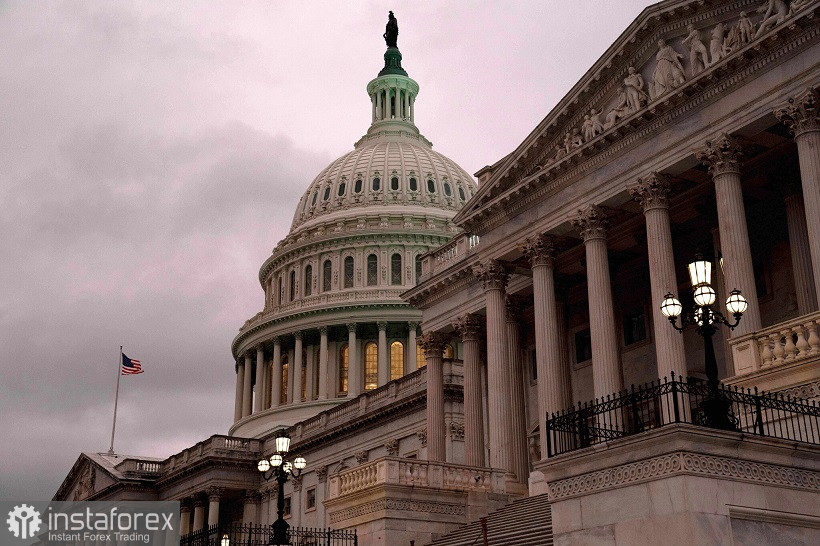Yesterday, the US Dollar index updated a 2.5-year low, reflecting the fall of the US currency throughout the market. The weakening of the greenback allowed the Euro-Dollar pair to update the next price high at 1.2273. Impulsive and rather large-scale price movements are usually followed by a correction. In this case, it did not take long. During the Asian session today, the Dollar index moved away from the lows and the EUR/USD pair retreated from the highs.
This dynamic is primarily due to the Friday factor which is when traders take profits without leaving open positions at extremes on the eve of the weekend. In addition, there was again some nervousness in the market associated with the discussion of a new stimulus package by US Congressmen. Also in the spotlight is Brexit. The negotiations around which are also alarming. In both cases, the negotiations dragged on and this fact provoked a small surge in anti-risk sentiment which the Dollar bulls took advantage of. But in my opinion, we are talking only about a corrective pullback and not a trend reversal. Therefore, if you do not take into account the Friday factor, the current market situation can be used to your advantage by opening trade deals against the US currency.

First of all, the focus is on events in the US Congress. The prolonged negotiation process on a stimulus package caused some concern among investors. The fact is that the parties have been assuring the public for a week that they are on the verge of a compromise solution. According to some estimates, congressmen were supposed to vote on Thursday. But yesterday, it turned out that politicians cannot agree on certain points of the agreement. According to Republican Senator Rob Portman, the negotiating team should complete its work this weekend.
Let me remind you that we are talking about a new, bipartisan bill which is the most promising agreement relative to previous legislative initiatives that were introduced by the Democrats or Republicans. The proposed assistance package consists of two parts. The first part is valued at $900 billion, $600 billion of which is planned to be covered by reprofiling other sections of the budget. If the measures are implemented, direct payments to Americans will amount to $600-700 and weekly unemployment benefits will be higher by $300 until March. It is planned to allocate $325 billion to support small businesses, $257 billion of which will go to the salary preservation program.
The second part of the bill is the most controversial and will most likely not be supported by congressmen. Democrats propose to allocate additional funds for the fight against the pandemic to state and municipal authorities as part of this part of the package, which is opposed by republicans.
Both Democrats and Republicans say that the negotiations are at the final stage. They also recognize that there are still unresolved issues that are still being discussed. For example, there was a dispute among politicians about whether to increase the reimbursement provided to municipalities by the Federal Emergency Management Agency.
Because of this, the negotiations were delayed again and this fact allowed the Dollar bulls to go for a short-term correction. Brexit also provided indirect support for greenback. Negotiations between London and Brussels were also delayed while the transition period was only a few days away. Negotiators similarly claim progress but at the same time note that there are differences on some key issues.
The general nervousness in the market is due to other news. Today it became known that the US Department of Commerce will blacklist about 80 Chinese companies that, according to Washington, have ties to the armed forces of the country. Now these companies will have to seek permission from the Ministry of Trade in order for suppliers from the United States to sell them any components.
In other words, the greenback got a temporary respite due to a combination of different fundamental factors against the background of the end of the trading week. But, in my opinion, there is no reason for a trend reversal for the EUR/USD pair. The positions of Dollar bulls are still vulnerable. According to the majority of experts surveyed by Bloomberg, congressmen will still pass the long-suffering bill on new incentives next week, given the high political risks for both Democrats and Republicans. Therefore, before the Christmas break, Congress will probably vote for the above agreement. Once this happens, the market will again be dominated by risk appetite while demand for the Dollar will again decline.

It is also worth noting that macroeconomic data that was published in the United States yesterday was quite disappointing . In particular, the increase in the number of initial applications for unemployment benefits continues to grow for the second week in a row. If the week before last, the indicator came out at around 716 thousand, then last week it jumped to 853 thousand. Yesterday, this indicator has already reached the level of 885 thousand. Against the background of rather weak non-farms, such trends are alarming.
The Philadelphia Fed Manufacturing Index also disappointed. Experts predicted its decline from 26 points to 20 but in reality it declined to the 11-point mark. This is the worst result since May of this year, when the indicator collapsed to -43 points amid the Coronavirus crisis.
From the technical point of view, the situation has not changed. On the daily chart, the pair is located between the middle and upper lines of the Bollinger Bands Indicator, as well as above all the lines of the Ichimoku Indicator which formed a strong bullish signal. This indicates the advantage of an upward movement. The main target of the upward movement is located on the upper line of the Bollinger Bands Indicator on the daily chart at the level of 1.2280.





















